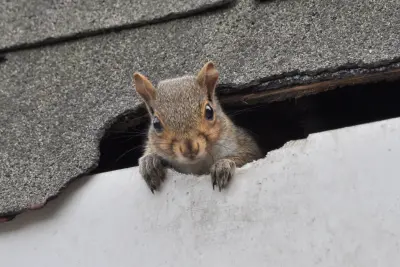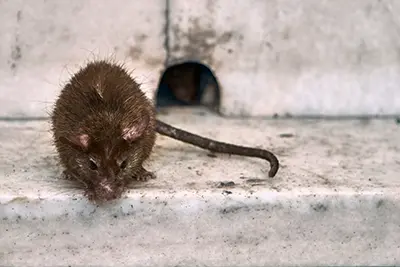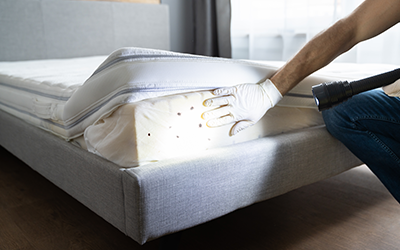Pests pose a serious threat to businesses, bringing damage and health risks to employees, customers, and owners alike. Uncontrolled, they can quickly multiply, making the problem worse. To combat this, Batzner Pest Control relies on exclusion services as a cornerstone of its integrated pest management (IPM) approach. This strategy prevents pests from entering your building and reduces their movement inside, addressing infestations at their source. Our team collaborates with you to create a customized pest control plan, delivering effective and practical solutions tailored to your business.
Pests That Frequently Infest Business Buildings
Pests don’t just threaten your property and health. They can also tarnish your business’s reputation. An infestation can make your business seem unhygienic and poorly managed. Be on the lookout for these common pests:
- Rodents: Known for causing extensive damage, rodents chew on building materials, machinery, and electrical wires. Mice can slip through gaps as small as ¼ inch, while rats need only an ½ inch opening to enter.
- Insects: Pests like cockroaches, stink bugs, and Asian lady beetles can tarnish your business’s reputation. Cockroaches, in particular, spread bacteria and diseases and can invade through cracks as small as 1/16 inch.
- Birds and Bats: Birds and bats create noise, mess, and hygiene issues on your property. Their droppings carry harmful diseases, with feral pigeons entering through gaps as small as two inches, sparrows needing ¾ inch, and bats squeezing through spaces as tiny as ⅜ inch.
- Wildlife: Wild animals like raccoons, squirrels, and opossums damage buildings by chewing on wires and insulation. They often enter through roof vents or open windows.
Pest Proofing Solutions for Your Business
Pest-proofing is a crucial first step in safeguarding your business against pests. When combined with a dependable pest management plan, it creates a robust defense against infestations. Batzner Pest Control provides a full range of Flexi Armour™ products and advanced pest-proofing solutions, such as:
- Flexi Armour Seal: A hybrid material made from a polymer compound and stainless steel that seals structural holes or gaps. It bonds to most surfaces and can be painted after it cures.
- Flexi Armour Shield: A durable stainless mesh tape used to seal smaller gaps around your business. It leaves no residue upon removal and can withstand various weather conditions.
- Flexi Armour Weep: A flexible, stainless steel mesh tube that can be cut to size, designed to block wall cavities and prevent rodents from entering buildings.
- Flexi Armour Expansion: A combination of flexible stainless steel mesh and a self-leveling compound, designed to seal expansion joints and prevent rodents from chewing through and accessing openings.
- Flexi Armour Ground Mesh: A corrosion-resistant, durable barrier placed on the ground to protect your business from underground pest invasions.
- Flexi Armour Dock: A solution made of Kevlar and steel mesh with a gap-filling material, designed to prevent rodents from entering through gaps around dock levelers.
- Flexi Armour Doors: Durable extruded rubber products with a knitted mesh core, designed to block rodent entry from gaps between doors and floors, both interior and exterior.
- Dual Autogate: A device specifically designed to detect rodents. Part of the PestConnect system is connected to traps, bait stations, and monitors to humanely capture and eliminate rodent pests.
- Vent Caps: Protects vents from large pests while allowing air to flow freely.
The Business Benefits of Effective Pest Control
Effective pest control plays a key role in protecting your business. It safeguards your property and contributes to maintaining a positive reputation. Here are the ways pest control can benefit your business:
- Protects Your Reputation: Keeping your business free of pests creates a positive image and builds trust with clients and customers.
- Prevents Property Damage: Pest control protects your building, equipment, and inventory from costly damage caused by rodents, insects, and other pests.
- Promotes Health and Safety: Effective pest management reduces the risk of diseases, ensuring a safer environment for employees and customers.
- Complies with Regulations: Proper pest control helps ensure your business adheres to health and safety standards in your industry.
- Improves Employee Productivity: A pest-free workspace boosts morale and reduces distractions, helping employees stay focused and productive.
- Reduces Costs: Ongoing pest prevention saves money by preventing costly repairs, disruptions, and fines.
- Enhances Customer Experience: A pest-free, clean environment leaves a lasting positive impression, encouraging customer loyalty and referrals.
Why Choose Batzner for Commercial Pest Control
With over 75 years of experience, Batzner Pest Control is a trusted leader in commercial pest management, offering effective solutions to protect your business. Our technicians, familiar with the local area, use their expertise to create tailored pest control plans that meet your specific needs. Backed by cutting-edge solutions and responsive service, we provide reliable and efficient pest management.
For trusted pest-proofing solutions and expert service, get in touch with Batzner Pest Control today.










